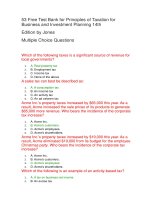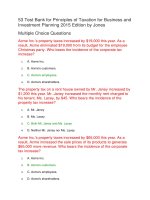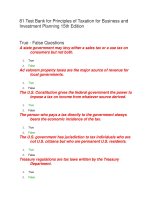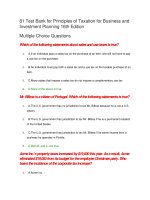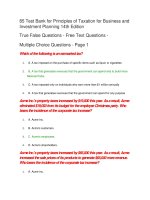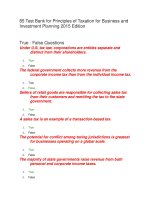Principles of taxation for business and investment planning 17th edition jones test bank
Bạn đang xem bản rút gọn của tài liệu. Xem và tải ngay bản đầy đủ của tài liệu tại đây (185.12 KB, 54 trang )
Chapter 02 - Policy Standards for a Good Tax
Chapter 02
Policy Standards for a Good Tax
True / False Questions
1. A tax meets the standard of sufficiency if it is easy for people to pay the tax.
True False
2. The federal government is not required to pay interest on the national debt.
True False
3. A static forecast of the revenue effect of a tax rate change assumes that the tax base does not
change.
True False
4. A dynamic forecast of the revenue effect of a tax rate change assumes that the tax base does
not change.
True False
5. The federal Social Security tax burden on employees has not increased since 1990 because
the tax rate has not increased since that year.
True False
6. If State H increases its sales tax rate by 1 percent, its sales tax revenue must also increase by
1 percent.
True False
2-1
© 2014 by McGraw-Hill Education. This is proprietary material solely for authorized instructor use. Not authorized for sale or distribution in
any manner. This document may not be copied, scanned, duplicated, forwarded, distributed, or posted on a website, in whole or part.
Chapter 02 - Policy Standards for a Good Tax
7. The city of Berne recently enacted a 10% tax on the price of a subway ticket. Consequently,
Mrs. Lane now walks to work instead of taking the subway. Her behavior illustrates the
substitution effect of a tax increase.
True False
8. Jurisdiction P recently increased its income tax rate. A taxpayer who reacts to the increase by
working harder to earn more income is demonstrating the income effect of the rate increase.
True False
9. According to supply-side economic theory, a decrease in tax rates for high-income
individuals could actually cause an increase in tax revenue.
True False
10. Supply-side economic theory holds that people who benefit from a tax rate reduction will
spend their tax windfall on consumption goods.
True False
11. State use taxes are more convenient for individual consumers than state sales taxes.
True False
12. The Internal Revenue Service's cost of collecting $100 of tax revenue is about $3.
True False
13. A convenient tax has low compliance costs for taxpayers and low collection and
enforcement costs for the government.
True False
2-2
© 2014 by McGraw-Hill Education. This is proprietary material solely for authorized instructor use. Not authorized for sale or distribution in
any manner. This document may not be copied, scanned, duplicated, forwarded, distributed, or posted on a website, in whole or part.
Chapter 02 - Policy Standards for a Good Tax
14. According to the classical concept of efficiency, an efficient tax should be neutral in its
effect on free market allocations of economic resources.
True False
15. According to the Keynesian concept of efficiency, an efficient tax should be neutral in its
effect on free market allocations of economic resources.
True False
16. A tax meets the standard of efficiency if it generates enough revenue to pay for the public
goods and services provided by the government.
True False
17. A provision in the tax law designed to encourage a specific economic behavior is a tax
preference.
True False
18. A good tax should result in either horizontal or vertical equity across taxpayers.
True False
19. Changes in the tax law intended to make the measurement of taxable income more precise
usually make the tax law less complex.
True False
20. Vertical equity focuses on measurement of the tax base, and horizontal equity focuses on
the tax rate structure.
True False
2-3
© 2014 by McGraw-Hill Education. This is proprietary material solely for authorized instructor use. Not authorized for sale or distribution in
any manner. This document may not be copied, scanned, duplicated, forwarded, distributed, or posted on a website, in whole or part.
Chapter 02 - Policy Standards for a Good Tax
21. Tax systems with regressive rate structures result in a proportionally heavier tax burden on
persons with smaller tax bases.
True False
22. A progressive rate structure and a proportionate rate structure both result in vertical equity
across taxpayers.
True False
23. The U.S. individual income tax has always used a progressive rate structure.
True False
24. The declining marginal utility of income across individuals can be measured empirically.
True False
25. Tax liability divided by taxable income equals marginal tax rate.
True False
26. If a tax has a proportionate rate structure, a taxpayer's marginal rate and average rate are
equal.
True False
27. If a tax has a progressive rate structure, a taxpayer's average rate is greater than her marginal
rate.
True False
28. The theory of distributional justice is a rationale for a progressive income tax system.
True False
2-4
© 2014 by McGraw-Hill Education. This is proprietary material solely for authorized instructor use. Not authorized for sale or distribution in
any manner. This document may not be copied, scanned, duplicated, forwarded, distributed, or posted on a website, in whole or part.
Chapter 02 - Policy Standards for a Good Tax
29. Individuals who believe that a tax system is fair are less likely to cheat on their taxes than
individuals who believe that the system is unfair.
True False
30. Many taxpayers believe the income tax system is unfair because it is so complicated.
True False
Multiple Choice Questions
31. Government officials of Country Z estimate that next year's public programs will cost $19
million but that tax revenues will be only $15 million. The officials could avoid a deficit next
year by adopting which of the following fiscal strategies?
A. Reduce the cost of public programs by $4 million.
B. Increase taxes by $4 million.
C. Borrow $4 million by issuing new government bonds.
D. All of these strategies will avoid a deficit.
32. Government officials of Country Z estimate that next year's public programs will cost $19
million but that tax revenues will be only $15 million. Which of the following statements is
false?
A. Country Z's tax system is sufficient.
B. Country Z's government is engaging in deficit spending.
C. If Country Z must borrow $4 million to pay for its public programs, its national debt will
increase by $4 million.
D. Country Z's government could balance its budget by eliminating a program that costs $4
million.
2-5
© 2014 by McGraw-Hill Education. This is proprietary material solely for authorized instructor use. Not authorized for sale or distribution in
any manner. This document may not be copied, scanned, duplicated, forwarded, distributed, or posted on a website, in whole or part.
Chapter 02 - Policy Standards for a Good Tax
33. Government J decides that it must increase its tax revenue. Which of the strategies should
result in more revenue?
A. Increase the rate of an existing tax.
B. Expand the base of an existing tax.
C. Enact a tax on a new base.
D. All of these strategies should result in more revenue for Government J.
34. The government of Nation C operated at a $32 billion deficit this year. The deficit suggests
that Nation C's tax system is:
A. Inefficient
B. Insufficient
C. Unfair
D. Inconvenient
35. The city of Belleview operated at an $865,000 surplus this year. The surplus suggests that
the municipal tax system is:
A. Fair
B. Efficient
C. Sufficient
D. Convenient
36. Which of the following statements concerning the federal Social Security tax is true?
A. The tax burden increases annually because the rate increases annually.
B. The tax burden increases annually because the base increases annually.
C. Both the rate and the base increase annually.
D. The Social Security tax burden has not increased since 1990.
37. A static forecast of the incremental revenue from a tax rate increase presumes that:
A. The tax base will not change because of the rate increase.
B. The tax base will increase by the same proportion as the rate increase.
C. The tax base will decrease by the same proportion as the rate increase.
D. The tax rate and the tax base are correlated.
2-6
© 2014 by McGraw-Hill Education. This is proprietary material solely for authorized instructor use. Not authorized for sale or distribution in
any manner. This document may not be copied, scanned, duplicated, forwarded, distributed, or posted on a website, in whole or part.
Chapter 02 - Policy Standards for a Good Tax
38. A dynamic forecast of the incremental revenue from a tax rate increase presumes that:
A. Taxpayers will not change their behavior because of the rate increase.
B. The tax base will increase by the same proportion as the rate increase.
C. The tax base will decrease by the same proportion as the rate increase.
D. The tax rate and the tax base are correlated.
39. Jurisdiction F levies a 10% excise tax on the purchase of golf carts. The annual revenue
from this tax averages $800,000 (10% * $8 million average annual golf cart purchases).
Jurisdiction F is considering raising the tax rate to 12%. Which of the following statements is
true?
A. The rate increase will increase revenue by $160,000.
B. Based on a dynamic forecast, the rate increase will increase revenue by $160,000.
C. Based on a static forecast, the rate increase will increase revenue by $160,000.
D. None of the above is true.
40. Last year, Government G levied a 35% tax on individual income, and Mr. Slate paid
$35,000 tax on his $100,000 income. This year, the government increased the tax rate to 40%.
Which of the following statements is false?
A. Based on a static forecast, government G should collect $5,000 additional tax from Mr. Slate
this year.
B. If Mr. Slate took a second job to maintain his after-tax disposable income, his behavior
illustrates a substitution effect of the rate increase.
C. If Mr. Slate took a second job to maintain his after-tax disposable income, government G
should collect more than $5,000 additional tax from him this year.
D. If Mr. Slate sold an income-generating investment and used the money for personal
consumption, his behavior illustrates a substitution effect of the rate increase.
2-7
© 2014 by McGraw-Hill Education. This is proprietary material solely for authorized instructor use. Not authorized for sale or distribution in
any manner. This document may not be copied, scanned, duplicated, forwarded, distributed, or posted on a website, in whole or part.
Chapter 02 - Policy Standards for a Good Tax
41. Which of the following statements about the substitution effect of an income tax rate
increase is false?
A. The substitution effect is theoretically stronger for high-income taxpayers than for
low-income taxpayers.
B. The substitution effect is theoretically stronger for a family's secondary wage earner than for
the family's primary wage earner.
C. The substitution effect is theoretically stronger for self-employed individuals who control
their own time than for employees whose work schedules are controlled by their employers.
D. None of the above is false.
42. Which of the following statements about the income effect of an income tax rate increase is
true?
A. The income effect is theoretically stronger for low-income taxpayers than for high-income
taxpayers.
B. The income effect is theoretically stronger for a family's secondary wage earner than for the
family's primary wage earner.
C. The income effect motivates individuals to find ways to increase their before-tax income.
D. Both A. and C. are true.
43. Which of the following statements about the income and substitution effects of an income
tax rate increase is true?
A. The income and substitution effects are contradictory behavioral reactions.
B. From the government's perspective, the substitution effect is more desirable than the income
effect.
C. Faith in the income effect is the foundation for supply-side economic theory.
D. Dynamic forecasts of incremental tax revenues must consider the potential income effect but
not the potential substitution effect of a rate increase.
44. Supply-side economic theory
A. Predicts that a decrease in the highest income tax rates will cause an increase in government
revenues.
B. Is inconsistent with the substitution effect.
C. Was a clear failure following the Reagan administration tax cuts of the 1980s.
D. Predicts that taxpayers will save their tax windfall from a rate cut rather than spend or
investment the windfall.
2-8
© 2014 by McGraw-Hill Education. This is proprietary material solely for authorized instructor use. Not authorized for sale or distribution in
any manner. This document may not be copied, scanned, duplicated, forwarded, distributed, or posted on a website, in whole or part.
Chapter 02 - Policy Standards for a Good Tax
45. Which of the following describes a tax that meets the standard of convenience?
A. A tax that the government can administer without excessive cost.
B. A tax that is easy for taxpayers to compute and pay.
C. A tax that minimizes the opportunity for noncompliance.
D. All of the above describe a convenient tax.
46. Which of the following taxes is most convenient for individuals to pay?
A. Sales tax
B. Use tax
C. Federal income tax
D. Real property tax
47. Which of the following statements regarding a convenient tax is false?
A. From the government's viewpoint, a good tax should be convenient to administer.
B. From the taxpayer's viewpoint, a good tax should be convenient to pay.
C. A convenient tax should have a method of collection that offers maximum opportunity for
noncompliance.
D. A convenient tax should permit taxpayers to compute their tax with reasonable certainty
without incurring undue costs.
48. Which of the following statements does not describe the classical standard of tax
efficiency?
A. An efficient tax is a neutral factor in a free market economy.
B. An efficient tax does not change taxpayer behavior.
C. An efficient tax encourages full employment.
D. An efficient tax favors a laissez-faire economy policy.
49. The statement that "an old tax is a good tax" means that:
A. Changes in the tax law create uncertainty in the business environment.
B. Changes in the tax law disrupt traditional planning strategies.
C. Changes in the tax law increase the compliance burden on businesses.
D. All of the above.
2-9
© 2014 by McGraw-Hill Education. This is proprietary material solely for authorized instructor use. Not authorized for sale or distribution in
any manner. This document may not be copied, scanned, duplicated, forwarded, distributed, or posted on a website, in whole or part.
Chapter 02 - Policy Standards for a Good Tax
50. The city of Hartwell spends about $3 million annually on snow removal. The city is
considering amending its real property tax law to allow homeowners to offset the cost of private
snow removal against their annual property tax liability. This amendment would affect the:
A. Fairness of the tax
B. Efficiency of the tax
C. Sufficiency of the tax
D. Convenience of the tax
51. Which of the following statements does not describe the Keynesian standard of tax
efficiency?
A. An efficient tax encourages economic growth.
B. An efficient tax encourages full employment.
C. An efficient tax encourages price-level stability.
D. All of the above describe the Keynesian standard of tax efficiency.
52. Government L levies a 4% excise tax on restaurant meals. It is considering reducing the rate
to 2% on meals served in restaurants that ban cigarette and cigar smoking and to increase the
rate to 5% in restaurants that allow smoking. Which of the following statements is true?
A. The rate change would improve the neutrality of the excise tax.
B. The rate change would improve the convenience of the tax.
C. The rate change is intended to affect social behavior.
D. Statements B. and C. are true.
53. The state of California plans to amend its personal income tax laws to allow parents to
reduce their tax by the cost of infant car seats. Which of the following statements is true?
A. The amendment creates a tax preference for parents who purchase infant car seats.
B. The amendment is intended to change social behavior.
C. The amendment increases the neutrality of the tax law.
D. Statements A. and B. are true.
2-10
© 2014 by McGraw-Hill Education. This is proprietary material solely for authorized instructor use. Not authorized for sale or distribution in
any manner. This document may not be copied, scanned, duplicated, forwarded, distributed, or posted on a website, in whole or part.
Chapter 02 - Policy Standards for a Good Tax
54. Which of the following statements concerning tax preferences is false?
A. Tax preferences increase the complexity of the law.
B. Tax preferences raise additional revenue for the government.
C. Tax preferences are government subsidies for targeted taxpayer activities.
D. Tax preferences do not improve the accurate measurement of the tax base.
55. Which of the following statements concerning tax preferences is true?
A. The annual revenue loss from federal tax preferences is quantified in the Tax Expenditures
Budget.
B. Tax preferences increase the fairness of the tax law.
C. Tax preferences simplify the tax law.
D. Tax preferences make the tax law more neutral across taxpayers.
56. Which of the following statements about horizontal equity is false?
A. Horizontal equity focuses on a rational and impartial measurement of the tax base.
B. Horizontal equity focuses on the measurement of taxpayers' ability to pay.
C. If persons with equal ability to pay a tax owe an equal amount of tax, the tax is horizontally
equitable.
D. None of the above is false.
57. The federal income tax law allows individuals whose property is destroyed by a natural
disaster such as a fire or hurricane to reduce their taxable income by the amount of their
financial loss. This rule is intended to improve the:
A. Convenience of the tax
B. Efficiency of the tax
C. Horizontal equity of the tax
D. Vertical equity of the tax
2-11
© 2014 by McGraw-Hill Education. This is proprietary material solely for authorized instructor use. Not authorized for sale or distribution in
any manner. This document may not be copied, scanned, duplicated, forwarded, distributed, or posted on a website, in whole or part.
Chapter 02 - Policy Standards for a Good Tax
58. The sales tax laws of many states exempt the purchase of groceries and prescription drugs
from tax. Such exemptions are intended to improve the:
A. Convenience of the tax
B. Equity of the tax
C. Sufficiency of the tax
D. Neutrality of the tax
59. Which of the following statements about vertical equity is false?
A. Vertical equity focuses on a fair rate structure instead of a fair measurement of the tax base.
B. If persons with greater ability to pay owe more tax than persons with lesser ability to pay, the
tax is vertically equitable.
C. A tax with a single percentage rate is not vertically equitable.
D. None of the above is false.
60. Jurisdiction M imposes an individual income tax based on the following schedule.
Rate
5%
Income bracket
$-0- to $50,000
+ 8%
$50,001 to $200,000
+ 12%
$200,001 and above
Which of the following statements is true?
A. The schedule provides no information as to whether Jurisdiction M's tax is horizontally
equitable.
B. Jurisdiction M's tax is vertically equitable.
C. Jurisdiction M's tax is vertically equitable only for individuals with $50,000 or less taxable
income.
D. Both A. and B. are true.
2-12
© 2014 by McGraw-Hill Education. This is proprietary material solely for authorized instructor use. Not authorized for sale or distribution in
any manner. This document may not be copied, scanned, duplicated, forwarded, distributed, or posted on a website, in whole or part.
Chapter 02 - Policy Standards for a Good Tax
61. Which of the following statements about a regressive tax rate structure is false?
A. A regressive rate structure cannot result in vertical equity.
B. Regressive rates decrease as the tax base increases.
C. A regressive rate structure places a proportionally heavier tax burden on taxpayers with
smaller tax bases than persons with greater tax bases.
D. None of the above is false.
62. Vervet County levies a real property tax based on the following schedule.
Rate
3%
+ 1%
Assessed value
$-0- to $250,000
$250,001 and above
Which type of rate structure does this tax use?
A. Proportionate
B. Regressive
C. Progressive
D. Dual-bracket
63. Vervet County levies a real property tax based on the following schedule.
Rate
3%
+ 1%
Assessed value
$-0- to $250,000
$250,001 and above
Bilex Inc. owns real property valued at $629,800. Compute Bilex's tax on this property.
A. $13,798
B. $7,500
C. $6,298
D. None of the above
2-13
© 2014 by McGraw-Hill Education. This is proprietary material solely for authorized instructor use. Not authorized for sale or distribution in
any manner. This document may not be copied, scanned, duplicated, forwarded, distributed, or posted on a website, in whole or part.
Chapter 02 - Policy Standards for a Good Tax
64. Vervet County levies a real property tax based on the following schedule.
Rate
3%
+ 1%
Assessed value
$-0- to $250,000
$250,001 and above
Which of the following statements is false?
A. If Mr. Clem owns real property valued at $112,500, his average tax rate is 3%.
B. If Ms. Barker owns real property valued at $455,650, her average tax rate is 2.1%.
C. If Ms. Lumley owns real property valued at $750,000, her marginal tax rate is 1%.
D. None of the above is false.
65. Which of the following statements about tax rate structures is true?
A. Regressive rate structures are illegal in the United States.
B. A tax with a graduated rate structure must be either regressive or progressive.
C. A proportionate rate structure is the only structure resulting in vertical equity.
D. None of the above is true.
2-14
© 2014 by McGraw-Hill Education. This is proprietary material solely for authorized instructor use. Not authorized for sale or distribution in
any manner. This document may not be copied, scanned, duplicated, forwarded, distributed, or posted on a website, in whole or part.
Chapter 02 - Policy Standards for a Good Tax
66. Jurisdiction M imposes an individual income tax based on the following schedule.
Rate
5%
Income bracket
$-0- to $50,000
+ 8%
$50,001 to $200,000
+ 12%
$200,001 and above
Which type of rate structure does this tax use?
A. Proportionate
B. Regressive
C. Progressive
D. Multi-bracket
2-15
© 2014 by McGraw-Hill Education. This is proprietary material solely for authorized instructor use. Not authorized for sale or distribution in
any manner. This document may not be copied, scanned, duplicated, forwarded, distributed, or posted on a website, in whole or part.
Chapter 02 - Policy Standards for a Good Tax
67. Which of the following statements about a progressive tax rate structure is false?
A. Progressive rates increase as the tax base increases.
B. Progressive rates reflect the theory of the declining marginal utility of income.
C. The federal income tax has always used a progressive rate structure.
D. Progressive rates result in greater vertical equity than a proportionate rate.
68. Which of the following statements about a proportionate income tax rate structure is false?
A. A theoretic justification for a proportionate rate is its superior potential for wealth
redistribution.
B. Under a proportionate rate structure, the marginal rate equals the average rate.
C. Under a proportionate rate structure, the taxpayer with the least income pays the same
percentage of income to the government as the taxpayer with the most income.
D. None of the above is false.
69. Which of the following statements concerning income tax rate structures is false?
A. Under a progressive rate structure, the marginal rate and the average rate are equal.
B. Under a regressive rate structure, the average rate for low-income individuals is more than
the average rate for high-income individuals.
C. Under either a regressive, proportionate, or progressive rate structure, high-income
taxpayers pay more dollars of tax than low-income individuals.
D. In theory, a progressive rate structure results in equal economic sacrifice across taxpayers.
70. Which of the following statements concerning a regressive tax rate structure is true?
A. A regressive tax rate structure is justified by the tax policy of distributive justice.
B. A regressive rate structure is justified by the theory of the declining marginal utility of
income.
C. Under a regressive rate structure, the average tax rate for high-income taxpayers is less than
the marginal tax rate.
D. None of the above statements is true.
2-16
© 2014 by McGraw-Hill Education. This is proprietary material solely for authorized instructor use. Not authorized for sale or distribution in
any manner. This document may not be copied, scanned, duplicated, forwarded, distributed, or posted on a website, in whole or part.
Chapter 02 - Policy Standards for a Good Tax
71. Jurisdiction M imposes an individual income tax based on the following schedule.
Rate
5%
Income bracket
$-0- to $50,000
+ 8%
$50,001 to $200,000
+ 12%
$200,001 and above
Mr. Coen has $78,000 taxable income. Compute the tax on this income.
A. $4,740
B. $6,240
C. $8,740
D. None of the above
72. Jurisdiction M imposes an individual income tax based on the following schedule.
Rate
5%
Income bracket
$-0- to $50,000
+ 8%
$50,001 to $200,000
+ 12%
$200,001 and above
Ms. Owen has $314,000 taxable income. Compute the tax on this income.
A. $29,680
B. $28,180
C. $37,680
D. None of the above
2-17
© 2014 by McGraw-Hill Education. This is proprietary material solely for authorized instructor use. Not authorized for sale or distribution in
any manner. This document may not be copied, scanned, duplicated, forwarded, distributed, or posted on a website, in whole or part.
Chapter 02 - Policy Standards for a Good Tax
73. Jurisdiction M imposes an individual income tax based on the following schedule.
Rate
5%
Income bracket
$-0- to $50,000
+ 8%
$50,001 to $200,000
+ 12%
$200,001 and above
Which of the following statements is true?
A. If Mrs. Hall's taxable income is $227,000, her average tax rate is 12%.
B. If Mr. Poe's taxable income is $41,200, his marginal tax rate is 8%.
C. If Ms. Kaye's taxable income is $63,800, her marginal tax rate is 8%.
D. None of the above is true.
74. Jurisdiction M imposes an individual income tax based on the following schedule.
Rate
5%
Income bracket
$-0- to $50,000
+ 8%
$50,001 to $200,000
+ 12%
$200,001 and above
Which of the following statements is false?
A. If Ms. Lui's taxable income is $33,400, her average tax rate is 5%.
B. If Mr. Bell's taxable income is $519,900, his marginal tax rate is 12%.
C. If Ms. Vern's taxable income is $188,000, her average tax rate is 7.2%.
D. None of the above is false.
2-18
© 2014 by McGraw-Hill Education. This is proprietary material solely for authorized instructor use. Not authorized for sale or distribution in
any manner. This document may not be copied, scanned, duplicated, forwarded, distributed, or posted on a website, in whole or part.
Chapter 02 - Policy Standards for a Good Tax
75. Congress originally enacted the federal estate and gift taxes to improve:
A. Distributional justice
B. Economic efficiency
C. Vertical equity
D. Horizontal equity
76. Which of the following tax policies would increase the redistribution of wealth across
society?
A. Repealing the federal estate and gift taxes
B. Increasing the highest marginal income tax rate by 10%
C. Replacing the progressive income tax rate structure with a flat rate
D. Replacing the income tax with a national sales tax
77. Which of the following statements concerning the standard of fairness is false?
A. People who believe that a tax is unfair are more likely to evade the tax.
B. People believe that the federal income tax is unfair because it contains preferences available
only to wealthy individuals.
C. The public perception that the federal income tax is unfair has decreased in recent decades.
D. None of the above is false.
78. Congress plans to amend the federal income tax to provide a deduction for the first $2,400
of residential rent paid by families with incomes below the federal poverty level. Which of the
following statements is true?
A. The amendment is intended to improve the efficiency of the tax.
B. The amendment is intended to improve the equity of the tax.
C. The amendment is intended to improve the simplicity of the tax.
D. The amendment is intended to improve the convenience of the tax.
2-19
© 2014 by McGraw-Hill Education. This is proprietary material solely for authorized instructor use. Not authorized for sale or distribution in
any manner. This document may not be copied, scanned, duplicated, forwarded, distributed, or posted on a website, in whole or part.
Chapter 02 - Policy Standards for a Good Tax
79. Congress plans to amend the federal individual income tax to eliminate the deductions for
medical care, educational savings, charitable contributions, and home mortgage interest. Which
of the following statements is true?
A. The amendment will reduce the complexity of the tax.
B. The amendment will increase the horizontal equity of the tax.
C. The amendment will increase the neutrality of the tax.
D. Statements A. and C. are true.
80. Congress plans to amend the federal income tax to provide a deduction for the cost of
energy-efficient fluorescent light bulbs. Which of the following statements is true?
A. The amendment is intended to improve the efficiency of the tax.
B. The amendment is intended to improve the equity of the tax.
C. The amendment is intended to improve the simplicity of the tax.
D. The amendment is intended to improve the convenience of the tax.
81. Congress recently amended the tax law to make it easier for individuals to file their income
tax returns electronically (online). Which of the following statements is true?
A. The amendment is intended to improve the efficiency of the tax.
B. The amendment is intended to improve the equity of the tax.
C. The amendment is intended to improve the simplicity of the tax.
D. The amendment is intended to improve the convenience of the tax.
Short Answer Questions
82. Mr. and Mrs. Boln earn $63,000 annual income and pay 20% in state and federal income tax.
If tax rates increase so that the couple's annual rate increases to 25%, how much additional
income must they earn to maintain their after-tax standard of living?
2-20
© 2014 by McGraw-Hill Education. This is proprietary material solely for authorized instructor use. Not authorized for sale or distribution in
any manner. This document may not be copied, scanned, duplicated, forwarded, distributed, or posted on a website, in whole or part.
Chapter 02 - Policy Standards for a Good Tax
83. Mr. Ohno owns and operates a part-time service business that generates $80,000 annual
taxable income. His federal tax rate on this income is 17%. Because of recent legislation, this
rate will increase to 25% next year.
A. Based on a static forecast, how much additional revenue will the federal government collect
from Mr. Ohno next year?
B. How much additional revenue will the federal government collect if Mr. Ohno decides to
work fewer hours and consequently earns only $50,000 next year?
84. The City of Willford levies a flat 7% tax on individual income in excess of $55,000.
Individuals who earn $55,000 or less pay no income tax.
A. Ms. Vello earned $127,200 income this year. Compute her city income tax and determine
her average tax rate.
B. Mr. Sui earned $68,900 income this year. Compute his city income tax and determine his
average tax rate.
C. Does Willford have a proportionate, progressive, or regressive tax rate structure?
2-21
© 2014 by McGraw-Hill Education. This is proprietary material solely for authorized instructor use. Not authorized for sale or distribution in
any manner. This document may not be copied, scanned, duplicated, forwarded, distributed, or posted on a website, in whole or part.
Chapter 02 - Policy Standards for a Good Tax
85. The country of Valhalla levies an income tax with the following rate structure.
Rate
5%
Income bracket
$-0- to $50,000
+ 10%
$50,001 to $150,000
+ 20%
$150,001 and above
A. Mrs. Greene's annual income is $125,000. Compute her tax, her average tax rate, and her
marginal tax rate.
B. Mr. Chen's annual income is $220,000. Computer his tax, his average tax rate, and his
marginal tax rate.
C. Does Valhalla have a proportionate, progressive, or regressive tax rate structure?
2-22
© 2014 by McGraw-Hill Education. This is proprietary material solely for authorized instructor use. Not authorized for sale or distribution in
any manner. This document may not be copied, scanned, duplicated, forwarded, distributed, or posted on a website, in whole or part.
Chapter 02 - Policy Standards for a Good Tax
Chapter 02 Policy Standards for a Good Tax Answer Key
True / False Questions
1. A tax meets the standard of sufficiency if it is easy for people to pay the tax.
FALSE
Difficulty: 1 Easy
Learning Objective: 02-01 Explain the concept of sufficiency of a good tax.
2. The federal government is not required to pay interest on the national debt.
FALSE
Difficulty: 1 Easy
Learning Objective: 02-01 Explain the concept of sufficiency of a good tax.
3. A static forecast of the revenue effect of a tax rate change assumes that the tax base does not
change.
TRUE
Difficulty: 1 Easy
Learning Objective: 02-01 Explain the concept of sufficiency of a good tax.
4. A dynamic forecast of the revenue effect of a tax rate change assumes that the tax base does
not change.
FALSE
Difficulty: 1 Easy
Learning Objective: 02-01 Explain the concept of sufficiency of a good tax.
2-23
© 2014 by McGraw-Hill Education. This is proprietary material solely for authorized instructor use. Not authorized for sale or distribution in
any manner. This document may not be copied, scanned, duplicated, forwarded, distributed, or posted on a website, in whole or part.
Chapter 02 - Policy Standards for a Good Tax
5. The federal Social Security tax burden on employees has not increased since 1990 because
the tax rate has not increased since that year.
FALSE
The Social Security tax burden increases annually because the tax base increases annually.
Difficulty: 2 Medium
Learning Objective: 02-01 Explain the concept of sufficiency of a good tax.
6. If State H increases its sales tax rate by 1 percent, its sales tax revenue must also increase by
1 percent.
FALSE
Difficulty: 1 Easy
Learning Objective: 02-01 Explain the concept of sufficiency of a good tax.
7. The city of Berne recently enacted a 10% tax on the price of a subway ticket. Consequently,
Mrs. Lane now walks to work instead of taking the subway. Her behavior illustrates the
substitution effect of a tax increase.
TRUE
Mrs. Lane substituted a nontaxable activity for a taxable activity.
Difficulty: 3 Hard
Learning Objective: 02-02 Differentiate between the income effect and the substitution effect.
8. Jurisdiction P recently increased its income tax rate. A taxpayer who reacts to the increase by
working harder to earn more income is demonstrating the income effect of the rate increase.
TRUE
Difficulty: 1 Easy
Learning Objective: 02-02 Differentiate between the income effect and the substitution effect.
2-24
© 2014 by McGraw-Hill Education. This is proprietary material solely for authorized instructor use. Not authorized for sale or distribution in
any manner. This document may not be copied, scanned, duplicated, forwarded, distributed, or posted on a website, in whole or part.
Chapter 02 - Policy Standards for a Good Tax
9. According to supply-side economic theory, a decrease in tax rates for high-income
individuals could actually cause an increase in tax revenue.
TRUE
Difficulty: 1 Easy
Learning Objective: 02-02 Differentiate between the income effect and the substitution effect.
10. Supply-side economic theory holds that people who benefit from a tax rate reduction will
spend their tax windfall on consumption goods.
FALSE
Supply-side economic theory predicts that people who benefit from a tax rate reduction will
invest their tax windfall in new economic ventures.
Difficulty: 3 Hard
Learning Objective: 02-02 Differentiate between the income effect and the substitution effect.
11. State use taxes are more convenient for individual consumers than state sales taxes.
FALSE
State sales taxes are more convenient because they are collected by the seller. Consumers must
pay use taxes directly.
Difficulty: 2 Medium
Learning Objective: 02-03 Describe the characteristics of a convenient tax.
12. The Internal Revenue Service's cost of collecting $100 of tax revenue is about $3.
FALSE
The IRS's cost of collecting $100 of tax revenue averages less than 50 cents.
Difficulty: 2 Medium
Learning Objective: 02-03 Describe the characteristics of a convenient tax.
2-25
© 2014 by McGraw-Hill Education. This is proprietary material solely for authorized instructor use. Not authorized for sale or distribution in
any manner. This document may not be copied, scanned, duplicated, forwarded, distributed, or posted on a website, in whole or part.

